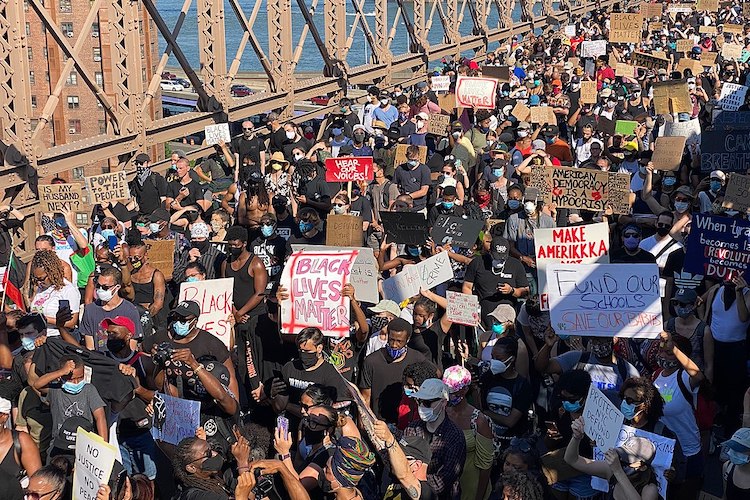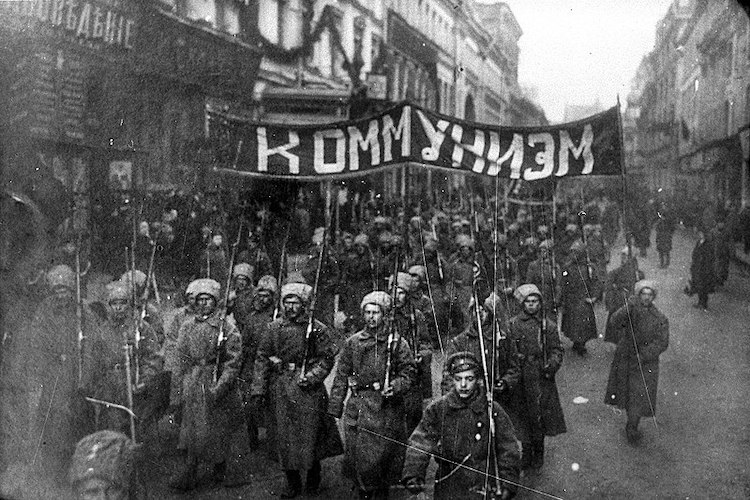As the protests over racial injustice and police brutality continue in the United States, the Kremlin is closely watching, but seemingly remains unfazed. The reason for this calm is that the imagery of chaos and violence coming from America validates one of Vladimir Putin’s core messages: liberal ideas lead to disorder, while a strong hand guarantees stability.

BLM protest on the Brooklyn Bridge, New York City on June 9, 2020. Photo: Stan Wiecher (Wikimedia Commons).
The wave of mass protests and civil unrest that started in late May in Minneapolis in the wake of the death of George Floyd at the hands of local police swept the entire United States, spilling over to other countries. By early July, up to 26 million had participated in protests spearheaded by the Black Lives Matter movement, making it the largest movement in US history. While most protests were peaceful, there were numerous instances of clashes with police, looting, and violence.
Naturally, none of these developments went unnoticed in Russia, where different social groups responded differently. For the elite, for example, the BLM upheaval indicated that the US is on the brink of collapse, even disintegration, while the Kremlin tried to take advantage of the video footage of looting and chaos. The official narrative thus focused on violence to underscore the notion that the masses are unruly beasts, and only strong autocratic power can save societies from chaos.
An analysis of state media commentators published recently in Foreign Affairs asserts that the Russian elite is not frightened by a potential spillover of the protests to Russia, but rather disappointed by these events, because an unstable America would be difficult to deal with. This is hardly the case.
In fact, most Russian observers are delighted that the US is engulfed in trouble, which, in their view, could lapse into a civil war and the breakdown of the country. Igor Panarin, a KGB graduate, now a political scientist with expertise in information warfare, first spoke about the same idea in 1998 and elaborated on in his 2009 book, titled “The Crash of the Dollar and the Disintegration of the USA.” His view was, however, that America would crash and disintegrate into six parts as a result of economic collapse. Last year, he released the second edition, in which he highlighted the polarization issue in the US and praised Donald Trump as a brilliant political leader who tries to prevent the country’s disintegration.
Around 15 years ago, Russian political commentator Stanislav Belkovsky wrote for the right-leaning Agency of Political News (APN), his own creation, that Western observers believed that it would be Russia, China, or Iran that were destined to resort to violence. But history is nothing if not ironic. Plus, consider the cognitive biases. If 19th-century pundits had been asked where a violent revolution could erupt, they would inevitably point to France, which had been caught up in revolutionary convulsions throughout the entire century. They would hardly think of Russia or Germany, which had been stable for generations. According to Belkovsky, the same fallacy might apply to the US: whereas Russia, despite the odds, could well escape a revolution, it might be America’s turn to plunge into self-destructive violence and inevitable collapse.
This grim vision of the American future is not new and has been discussed by some factions in the US itself. In 2017, on the centennial of the Bolshevik Revolution, the New Yorker’s Evan Osnos outlined a potential scenario for a violent revolution in the US and the consequences for the “super-rich.” Some of them, he wrote, would be able to weather the upheaval in bunkers or well-guarded, gated estates, while others would flee to countries like New Zealand and Australia. Then in July 2020, Princeton University professor Harold James published an article in the Project Syndicate titled “Late Soviet America,” in which he directly compared the present-day United States to the late Soviet Union.
The Kremlin is clearly aware of these narratives inside the US and would hail an American collapse as it would release Russia from US pressure. Still, there is another reason why the Kremlin—and Putin, in particular—might enjoy watching violence in the US and having Russians judge it. In a way, events in the US validate his legitimacy.
While a good number of observers believe that Putin has no legitimacy and relies exclusively on coercion and propaganda, this image of the regime and its relationship with the Russian people is one-sided. When he came to power in 2000, Putin enjoyed strong legitimacy. The so-called likhie devianostye (“unhinged nineties”) in Russia had left a difficult legacy. The spread of crime and the perception of general chaos were the period’s unmistakable attributes, which bothered large numbers within both the elite and the masses. Putin’s emergence as a man of law and order, despite his authoritarian means, resonated with many Russians, even Westernized liberals. Within a decade, by the time of Putin’s de facto third term, Russian society had stabilized. Violent crime was mostly tamed; large Russian cities had become safe, prosperous places.
This success, however, didn’t play well for Putin’s legitimacy—an autocrat doesn’t need a stable society, as its appetite for political freedom starts to grow. To address this concern, the Kremlin embarked on a campaign showing both the population and observers in the West that this “stability” was deceptive, and without a strong hand, the country risked sliding back into violent turbulence akin to the 90s.
The message was disseminated in several ways. One of them was the 2011 international conference (attended by the author of this piece) on Alexander Solzhenitsyn’s magnum opus, The Red Wheel, focusing on the events leading up to the Bolshevik dictatorship. Solzhenitsyn believed that the end of the monarchy instilled in Russian liberals the illusion that the country could survive without a strong hand—a myopic view. With autocracy’s demise, the country lapsed into criminalized anarchy, which was only “normalized” by millenarian brutes—the Bolsheviks.
These ideas aligned with the narratives pushed by the Kremlin, which clearly sponsored the event. Numerous foreign scholars were invited to participate for free (all expenses paid by the organizers). Solzhenitsyn’s wife, Natalia, told me also that she had not contributed to the conference fund, and that Solzhenitsyn’s family could hardly afford such an enterprise.
The Kremlin’s message was clear: those trying to sway the public to oppose the regime were playing with fire. While being illiberal, the regime was not bloody. Nor did it harbor fantasies to forcefully transform Russia into a global leader. Despite all shortcomings, the regime seemed to provide even the liberal-minded with a modicum of stability and even freedom. However, its overthrow would tip Russia inevitably into violence, which would hurt everyone, including liberals.

October 1917: Armed soldiers carry a banner reading “Communism.” Photo: CTK (via Wikimedia Commons).
In fact, the narrative goes, it is the liberals who would be first targeted by the mob fury. This idea is borrowed from the work of Mikhail Gershenzon, a Russian Jewish intellectual, who organized the publication of Vekhi (“Landmarks”)—a collection of articles by Russian philosophers (including Nikolai Berdyayev, Sergei Bulgakov, and Peter Struve) on the 1905 Revolution, which caused a great stir at the time of its release in 1909. Gershenzon, who also contributed to the volume, wrote that liberal intellectuals made a great mistake in fighting autocracy and siding with the masses, who, in his view, were an “untamed beast.” Instead, Gershenzon held, liberals should support autocracy, in which the “bayonet is the only force which saves us from the fury of the masses.”
This message, even as it was pushed during the December 2011 conference, did not sit well with the Russian people. Ironically, the Kremlin-sponsored event took place around Russia’s parliamentary elections, characterized by massive rigging. People reacted with a series of mass protests, which started off in central Moscow and spread around the country. Shocked at first, the Kremlin reacted as any autocratic regime would by tightening the screws and bolstering propaganda.
Fast-forward nine years, despite the international isolation and economic downturn, the regime still sticks to its narratives. The US protests, with its graphic imagery, might have provided Putin and other autocrats with new grist for their mill, backing up the claim that the unhinged masses, even in the civilized West, can be dangerous. That is to say, only a strong hand can save society from meltdown.
Still, there are signs that the power of the Kremlin’s messages is weakening, as the people of the Khabarovsk region in the Russian Far East took to the streets for over two weeks this July, defending their constitutional rights in an orderly and civil way. In their eyes, Putin has emerged not so much as a symbol of stability, but as a corrupt autocrat, who just enriches himself and his cronies.